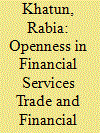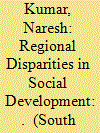| Srl | Item |
| 1 |
ID:
165526


|
|
|
|
|
| Summary/Abstract |
In a developing country like Bangladesh, the devolved local government system is widely recognized as one of the key institutional forms for the citizen-centric public service delivery system and ensuring democratic governance at the grassroots level. However, the democratic nature of local governments and their effective role in rendering services are contingent upon the political and institutional environments of the country. Competitive electoral process is key to local democratic governance. The purpose of this article is to analyze the implications of contemporary political order and institutional environments for the proper functioning of the Union Parishad (council), the lowest tier of the local government system in Bangladesh. More specifically, this study will reflect on how political clientelism, partyarchy and institutional environments have stymied competitive electoral politics at the local level which may result in democratic backsliding.
|
|
|
|
|
|
|
|
|
|
|
|
|
|
|
|
| 2 |
ID:
165524


|
|
|
|
|
| Summary/Abstract |
Indian government has infused `250,000 million in the year 2016 and 2017 followed by `100,000 million within the year 2018 and 2019 with an inspiration of reducing the non-performing assets (NPAs) levels of public sector banks (PSBs). Figuring among the top 20 banks with the highest gross non-performing asset (GNPA) ratios, according to CARE Ratings’ analysis of the first quarter results of 38 banks, PSBs are more stressed than their private sector counterparts. On a quarter-on-quarter basis, the increase in NPAs has been the highest in Quarter 1 FY18 witnessing a rise of 16.6 per cent, achieving `8,293,380 million as of June 2017. This study is an effort to study the impact of NPAs, causes, suggestive measures and the need of recapitalisation of PSBs to tackle the crisis. It further suggests a standardised model which can help banks to keep in check of additional capital required for maintaining minimum CET 1 as per regulatory norms.
|
|
|
|
|
|
|
|
|
|
|
|
|
|
|
|
| 3 |
ID:
165525


|
|
|
|
|
| Summary/Abstract |
This article investigates the long-run relationship between openness in financial services trade (OPTIFS) and financial development in five BRICS (Brazil, Russia, India, China and South Africa) economies, for the period of 1990–2012. It is found that the variables under consideration possess a long-run relationship in the mentioned economies. Fully modified ordinary least square (FMOLS) and dynamic ordinary least square (DOLS) have been performed to find the long-run coefficient of the variables. Results from FMOLS and DOLS have confirmed that OPTIFS has a positive and significant impact on financial development. The study reveals that 1 per cent increase in trade in financial services causes 0.109 increase in total credit to private sector, which is used as a proxy for financial development, indicating that the government should try to remove barriers from trade in financial services in order to develop better financial structure, thereby promoting further growth. It is also found that some of the control variables like gross savings and gross domestic product have positive and significant impact on financial development at 5 per cent level of significance
|
|
|
|
|
|
|
|
|
|
|
|
|
|
|
|
| 4 |
ID:
165523


|
|
|
|
|
| Summary/Abstract |
The present study examines the regional disparities in social development in India by using social development index (SDI). The study used census-based data of 2011 including 28 states and seven union territories (UTs) of India. The study ends by ranking of states and UTs on the basis of development index consisting of 12 social indicators. This article also compares selected states on the basis of human development index (1981, 1991 and 2001) and SDI (2011) values. In addition, the study finds district-level SDI and ranks the districts of selected states, that is, Kerala, Haryana and Bihar. The findings of the study confirmed the northern–southern social development divide in India. The empirical findings show that Kerala is the best state among all states in India in terms of social progress. Results of the study confirmed huge disparities at district and states/UTs level in India.
|
|
|
|
|
|
|
|
|
|
|
|
|
|
|
|